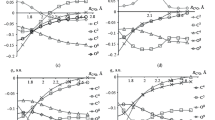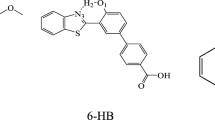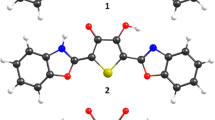Abstract
A systematic calculation of the potential curves or surfaces for 1,2-shift has been realized by using MNDO or other models in MOPAC programs. By referring to the previous author’ viewpoints, the 1,2-shift can be divided into two categories. 1,2-electron-deficient shift is that the electronic configuration of the atom which accepts the migrating group is a cation or an electron-deficient atom, and 1,2-anion shift is the one that the accepted atom of the migration group is a negative ion. In terms of the experimental facts and the calculation of the potential surfaces, in electron-deficient shift such as Beckmann or Baeyer-Villiger rearrangement, the migration occurs through a transition complex formed between the π-bond and the cation or electron-deficient migrating group, but in anion shift such as Wittig or Stevens rearrangement, the electron pair in π-orbit excites at first to π orbit, and then the migration occurs through the new formed complex between the anion migration group and the vacant π orbit. The above mechanisms explain reasonably the intramolecular properties, the configuration retentions of the migration group, and the corresponding migratory aptitudes of the two type 1, 2-shifts. The partial and less important free radical reaction of 1, 2-anion shift has been explained by the π-complex mechanism too.
Similar content being viewed by others
References
Dai Qianhuan, Research on mechanism of chemical carcinogenesis and quantitative structure-carcinogenic activity relationship, Scientia Sinica, 1980, 23(4): 453.
Dai Qianhuan, Zhang Qingrong, Wang Lihui et al., Experimental verification on chemical carcinogenesis,a bifunctional alkylation between DNA interstrands, Chinese Science Bulletin, 2000, 45(12): 1075.
Dai Qianhuan, Liu Xin, DNA interstrand cross-link induced by estrogens and their complete as well as synergic carcinogenesis, Chinese Science Bulletin, 2000, 45(23): 2125.
Dai Qianhuan, Quantum chemical rules of electrophilic additions, Journal of Beijing Polytechnic University (in Chinese), 1986, (2): 1.
Dai Qianhuan, Liu Ronghua, EHMO quantitative verification of quantum theory mechanism for electrophilic additions, Chinese Science Bulletin, 1992, 37(9): 732.
Dai Qianhuan, Liu Yunhua, Li Rongxiang, Research on stereochemistry of Prins reaction of cyclohexene, Chinese Science Bulletin, 1989, 34(12): 2045.
Leach, A. R., Molecular Modelling, Harlow: Addison Wesley Longman Limited, 1996, 90–130.
CS Chem3D 4.0, Software, User’s Guide, Chem3D Molecular Modeling and Analysis, Combridge: Combridge Soft Corp., 1997, 145–164.
March, J., Advanced Organic Chemistry, 4th ed., New York: John Wiley & Sons, 1992, 1051–1109.
Lowry, T. H., Richardson, K. S., Mechanism and Theory in Organic Chemistry, 3rd ed., New York: Happer and Row, 1987, 425–515, 538–541.
Dewar, M. J. S., The Molecular Orbital Theory of Organic Reactions, New York: McGraw-Hill, 1969, 483–486.
Rajyaguru, I., Rzepa, H. S., A MNDO SCF-MO study of the mechanism of the benzilic acid and related rearrangements, J. Chem. Soc., Perkin Trans., 1987, 2(12): 1819.
Nakai, T., Mikami, K., [2,3]-Wittig sigmatropic rearrangement in organic synthesis, Chem. Rev., 1986, 86(5): 885.
Bansal, R. K., Organic Reaction Mechanisms, 2nd ed., New Delhi: Tata McGraw-Hill, 1986, 282–312.
Kim, C. K., Lee, B. S., Lee, I., Determination of reactivity of MO theory, Part 80, Theoretical studies on the gas-phase rearrangement of deprotonated alkyl phenyl ether, J. Phys. Org. Chem., 1992, 56(2): 812.
Author information
Authors and Affiliations
Corresponding author
Rights and permissions
About this article
Cite this article
Dai, Q., Zhou, Z. & Zhang, D. Mechanism of 1,2-shift through π-complex transition state. Sc. China Ser. B-Chem. 43, 576–586 (2000). https://doi.org/10.1007/BF02969505
Received:
Issue Date:
DOI: https://doi.org/10.1007/BF02969505




